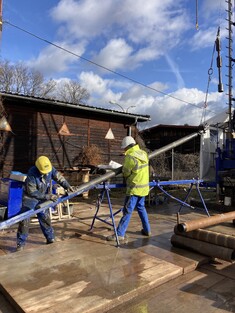For this reason, the pilot borehole was planned to a depth of up to 550 metres, which is the maximum depth considered for the future high temperature BTES storage field in Litoměřice. Rock samples are thus taken continuously from a depth of approximately 35 m to the target depth of 550 m. Core recovery during drilling is not a straightforward process, as it is necessary to bring the drilled samples to the surface, which takes longer and longer as the depth increases. The core barrel, a 3 m (sometimes up to 9 m) long steel barrel into which the drilled rock is progressively deposited by coring, must be pulled out and the core removed when it is full. Normally, however, the drill rods on which the barrel is suspended, which are about 6 m long and are screwed together and lowered into the borehole, would have to be pulled out first. For example, more than 80 drill rods are bolted together at a depth of 500 m. This process is very time-consuming, so a much more efficient method is used, the so-called "wire line coring", in which the core line is pulled up on a wireline using a clamping device designed for this purpose - the so-called "overshot". The drill rods are hollow and larger in diameter than the core line itself, which allows the core line to be pulled up with a winch without the drill rods having to be disconnected and pulled up one by one, and this process repeated every 3 metres. Once the core has been removed, the core barrel is lowered back into the borehole where it can continue to drill and retrieve a further 3 metres of sample once it has been successfully attached back to the drill column. Once the core is brought to the surface, the core is transferred from the core barrel to the drill rig's trough rack where it is checked for condition, percentage yield (depending on the geology, some core may be incoherent and wash out on the way to the surface) and initially geologically documented. It is then moved into prepared wooden boxes 1 metre long, where it is carefully wrapped in plastic to protect it from drying out, so that the subsequent physical measurements on the samples are as close as possible to the actual conditions in the borehole and therefore to the rock itself.




